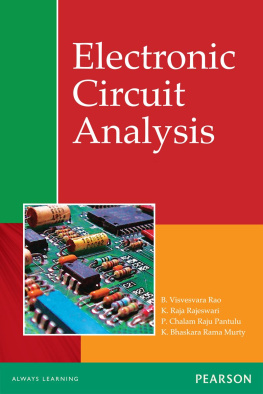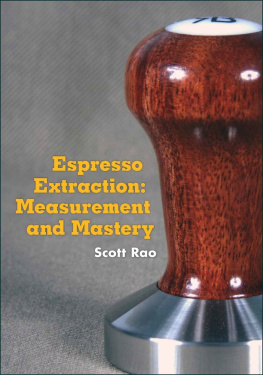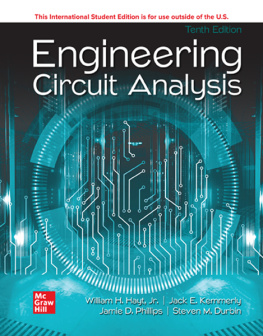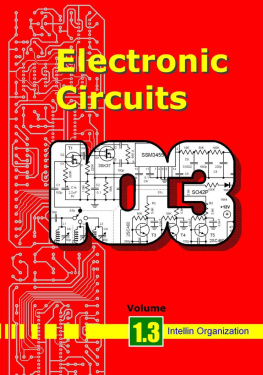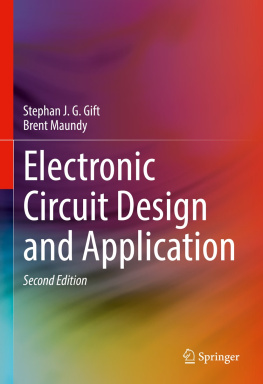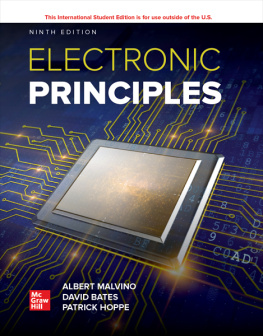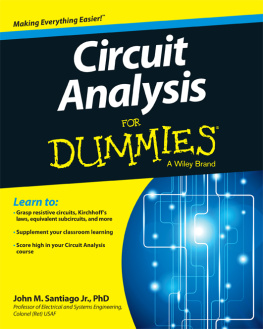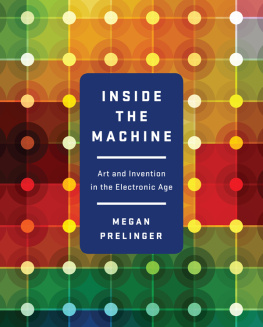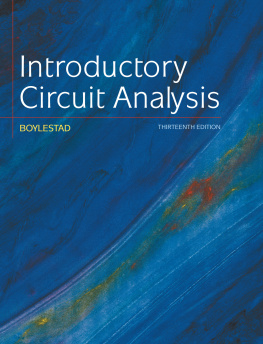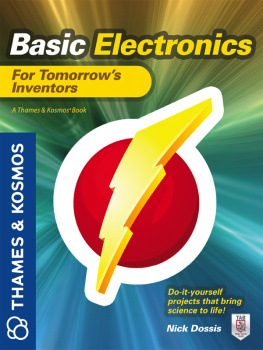Rao - Electronic circuit analysis
Here you can read online Rao - Electronic circuit analysis full text of the book (entire story) in english for free. Download pdf and epub, get meaning, cover and reviews about this ebook. City: Chennai, year: 2012, publisher: Pearson, genre: Computer. Description of the work, (preface) as well as reviews are available. Best literature library LitArk.com created for fans of good reading and offers a wide selection of genres:
Romance novel
Science fiction
Adventure
Detective
Science
History
Home and family
Prose
Art
Politics
Computer
Non-fiction
Religion
Business
Children
Humor
Choose a favorite category and find really read worthwhile books. Enjoy immersion in the world of imagination, feel the emotions of the characters or learn something new for yourself, make an fascinating discovery.
- Book:Electronic circuit analysis
- Author:
- Publisher:Pearson
- Genre:
- Year:2012
- City:Chennai
- Rating:4 / 5
- Favourites:Add to favourites
- Your mark:
- 80
- 1
- 2
- 3
- 4
- 5
Electronic circuit analysis: summary, description and annotation
We offer to read an annotation, description, summary or preface (depends on what the author of the book "Electronic circuit analysis" wrote himself). If you haven't found the necessary information about the book — write in the comments, we will try to find it.
Electronic circuit analysis — read online for free the complete book (whole text) full work
Below is the text of the book, divided by pages. System saving the place of the last page read, allows you to conveniently read the book "Electronic circuit analysis" online for free, without having to search again every time where you left off. Put a bookmark, and you can go to the page where you finished reading at any time.
Font size:
Interval:
Bookmark:
B. Visvesvara Rao
Professor
Mahaveer Institute of Science and Technology
Hyderabad
K. Raja Rajeswari
Professor
Department of Electronics and Communication Engineering
Andhra University College of Engineering (Autonomous)
Andhra University
Vishakapatnam
P. Chalam Raju Pantulu
Divisional Engineer (Retired)
Control and Instrumentation
Andhra Pradesh Power Generation Corporation Limited
K. Bhaskara Rama Murty
Former Associate Professor
Department of Electronics and Communications Engineering
JNTU College of Engineering
Kakinada

Chennai Delhi Chandigarh
To my beloved wife, Late B. Laxmana Mani, whose unquestioned support, love and
affection allowed me to dream big and deliver on a project of this scale
B. Visvesvara Rao
Electronic Circuit Analysis is designed to serve as a text and reference book for two-semester courses of B.Tech. curriculum of various universities in India and abroad (B.S. with engineering major).
The working principles of electronic devices such as diodes and transistors (BJT, FET and MOSFET) are explained with simple text, diagrams, equations and worked-out examples to impart a deep understanding of the device functions.
From radio communication systems to cellular phones, all electronic equipments including computers, satellite communication systems, real-time embedded systems and Internet communication technologies use contraptions such as amplifiers, oscillators, power amplifiers, tuned amplifiers and power supplies as basic building blocks. The analysis of the electronic circuits required to build such applications is presented in easily understandable methods to give students a firm foundation in the first principles and enable them to probe advanced and application topics such as very-large-scale integration (VLSI) and nano technologies.
The topics are disseminated in a clear step-by-step approach that provides teachers ample material to empower their students. They are also conceived for students to further their understanding through self-study.
on Electron Dynamics presents the basic principles of movement of charge carriers, electrons, in electric and magnetic fields. Structural details of the cathode ray tube (CRT) and operation of the cathode ray oscilloscope are explained.
on P-N Junction Diode Characteristics deals with the basic physics of the PN junction diode and uses energy band diagrams to explain the flow of diode currents under different biasing conditions. Interpreting the behaviour of PN junctions, diode characteristics and charge movement is basic to understand the function of transistors in different electronic applications.
on Rectifiers, Filters and Voltage Regulators speaks about these fundamental components and their role in designing DC power supply circuits. Rectifier circuits are good examples for diode applications, and DC power supply is a core component supplying power to all electronic gadgets/products.
on Characteristics of Transistor Devices (BJT, FET and MOSFET) expounds on the principal component of all electronic circuitsthe Transistorand the physics behind the different options of its assembly leading to the BJT, FET and MOSFET type of Transistors. The methods of obtaining Transistor VI characteristics for each type are also spelt out. The Transistor's amplifier action is explained using its VI characteristics and equations. Transistor characteristics are useful in the design and analysis of electronic circuits that are built with these core components.
on Transistor Biasing and Stabilisation Circuits advances a qualitative discussion and analysis of the different types of biasing circuits of transistor amplifiers, including the establishment of a stable quiescent operating point (key design parameter) under DC/biasing/operating voltages. It also discusses compensation circuits to stabilise the operating point against variations in temperatures and biasing voltages.
on Transistor (BJT) Amplifiers illustrates the basic configurations of BJT amplifiers and their h-parameter equivalent circuits. Continuing from the previous chapter, amplifier operation is analyzed under DC/biasing/operating and (input) signal voltages, leading to the development of different classes of amplifiers and their applications. Key parameters such as amplifier frequency response and bandwidth are calculated and analyzed.
on Feedback Amplifiers elucidates the principles of different feedback techniques that modify the characteristic features of amplifiers. Various types of negative feedback topologies that lead to stabilisation of amplifiers for performance are discussed. Practical electronic circuits using these feedback techniques (such as voltage series and shunt, and current series and shunt) are examined.
on Oscillators describes the basic operating principle of RC and LC oscillators for low- and high-frequency applications, respectively. It explains the different stable oscillator circuits using crystals (used as clocks in all electronic gadgets) in detail. It also explores the sweep circuit (used in major tube devices radar displays, TV, CRO) built using UJT-based negative resistance oscillator.
on FET and MOSFET Amplifiers delineates amplifier operations using FET and MOSFET devices, which are suitable for miniaturization and high-speed operations at low power and used as basic amplifier building blocks in VLSI and low-power electronic gadgets such as mobile phones, satellite and communication systems.
on Multistage (Cascaded) Amplifiers takes a close look at building long multistage amplifiers, bridging basic amplifier blocks for signal gain and increased useful frequency bandwidth, cascading for optimum power transfer adjusted to different input and output impedance levels. High-input impedance circuits for high gain using Darlington pair transistors are detailed to demonstrate high-end applications. As in the other chapters, calculations and analysis support the discussion on designing and building of these multistage (cascaded) amplifiers.
on Large Signal (Power) Amplifiers depicts the design of audio frequency (AF) amplifiers (used in smart and mobile phones, home theaters, radio and TV transmitters and receivers with speakers). Increased power is realised through pushpull amplifiers, the different variations (input and output powers and efficiency) of which are analyzed in detail in this chapter. Class C amplifiers (in radio and TV transmitters) with high efficiency and power are discussed. Modern versions such as Classes D and E amplifiers (home theaters), with lower noise levels and high speed operation, are also outlined.
on High Frequency Transistor Circuits speaks about high-frequency equivalent circuits that use the hybrid- model for BJT, FET and MOSFET, using key parameters such as junction capacitance. These are required to adapt to the present-day high-frequency applications (such as WiFi and 3G) that need specialised analysis and techniques.
on Tuned Amplifiers spells out the basic principles of tuned amplifiers, single and double tuned amplifiers. These special circuits come into play when a TV or radio is tuned to a specific channel or station. The chapter also looks at synchronously tuned and stagger tuned amplifiers used for better and faster selectivity, while revealing the basic principles and techniques of circuit design to neutralise and stabilise high-frequency effects.
on Switching and IC Voltage Regulators focuses on the analysis and design of different types of voltage regulators, three-terminal IC regulators and special types of voltage regulator circuits. With different voltages being used by different circuit modules inside electronic gadgets (laptops, computers) or special embedded systems (cable/SoHo LAN/WiFi gateway), these voltage regulators are used to interface/translate voltages across different circuit modules. The chapter also sketches the working of DCDC regulator power supply circuits, switching regulators, SMPS and UPS.
Font size:
Interval:
Bookmark:
Similar books «Electronic circuit analysis»
Look at similar books to Electronic circuit analysis. We have selected literature similar in name and meaning in the hope of providing readers with more options to find new, interesting, not yet read works.
Discussion, reviews of the book Electronic circuit analysis and just readers' own opinions. Leave your comments, write what you think about the work, its meaning or the main characters. Specify what exactly you liked and what you didn't like, and why you think so.

